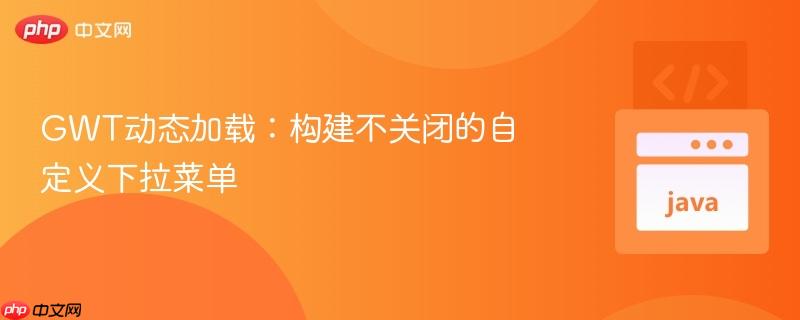
在gwt中,默认的listbox在选择项后会自动关闭,这为实现带有“加载更多”功能的动态下拉列表带来了挑战。为了解决这一问题,推荐的方案是构建一个自定义的下拉组件,利用gwt的button模拟下拉框外观,并结合popuppanel来承载可动态更新的列表内容。这种方法提供了完全的控制权,允许在点击“加载更多”时保持下拉列表的打开状态,从而实现流畅的用户体验。
GWT的ListBox组件是一个常用的下拉列表控件。然而,其默认行为是在用户选择列表中的任何项后立即关闭下拉菜单。当我们需要实现一个带有“加载更多”功能的下拉列表时,这个特性就成为了一个障碍。例如,如果列表末尾有一个“加载更多”选项,用户点击它期望加载更多数据并保持列表打开,但ListBox的默认行为会导致它关闭,从而破坏了用户体验。每次加载数据后,用户都必须重新点击下拉框才能看到新加载的内容。
鉴于ListBox的固有局限性,最有效的解决方案是放弃使用ListBox,转而构建一个自定义的下拉组件。这种方法允许我们完全控制组件的行为,包括何时打开、何时关闭,以及如何处理内部元素的交互。
核心思路是:
创建一个Button,并应用CSS样式使其看起来像一个标准的下拉框。当用户点击这个按钮时,我们将显示PopupPanel。
import com.google.gwt.user.client.ui.Button;
import com.google.gwt.user.client.ui.PopupPanel;
import com.google.gwt.event.dom.client.ClickHandler;
import com.google.gwt.event.dom.client.ClickEvent;
import com.google.gwt.user.client.ui.VerticalPanel;
import com.google.gwt.user.client.ui.Label;
import com.google.gwt.user.client.ui.Anchor; // 或者Button作为Load More
import com.google.gwt.user.client.Window; // 用于模拟异步回调
public class CustomDropdown extends Composite {
private Button dropdownButton;
private PopupPanel popupPanel;
private VerticalPanel contentPanel; // 存放列表项和“加载更多”按钮
private Anchor loadMoreAnchor; // 或者Button
private int currentItemCount = 0;
private final int ITEMS_PER_LOAD = 5;
public CustomDropdown() {
initUI();
}
private void initUI() {
dropdownButton = new Button("选择项目");
dropdownButton.addStyleName("custom-dropdown-button"); // 自定义CSS样式
contentPanel = new VerticalPanel();
contentPanel.addStyleName("custom-dropdown-content");
popupPanel = new PopupPanel(true); // true表示点击外部区域自动关闭
popupPanel.add(contentPanel);
popupPanel.addStyleName("custom-dropdown-popup");
// 初始加载一些数据
loadInitialItems();
// 为下拉按钮添加点击事件
dropdownButton.addClickHandler(new ClickHandler() {
@Override
public void onClick(ClickEvent event) {
if (!popupPanel.isShowing()) {
// 显示PopupPanel,并定位在按钮下方
popupPanel.setPopupPositionAndShow(new PopupPanel.PositionCallback() {
@Override
public void setPosition(int offsetWidth, int offsetHeight) {
int left = dropdownButton.getAbsoluteLeft();
int top = dropdownButton.getAbsoluteTop() + dropdownButton.getOffsetHeight();
popupPanel.setPopupPosition(left, top);
}
});
} else {
popupPanel.hide();
}
}
});
initWidget(dropdownButton); // 将按钮作为主组件
}
private void loadInitialItems() {
// 清除现有内容(如果需要)
contentPanel.clear();
currentItemCount = 0;
// 模拟加载前5个项目
addItems(ITEMS_PER_LOAD);
addLoadMoreButton();
}
private void addItems(int count) {
for (int i = 0; i < count; i++) {
Label item = new Label("项目 " + (currentItemCount + 1));
item.addStyleName("custom-dropdown-item");
// 为每个项目添加点击事件 (可选,根据需求决定是否关闭popup)
item.addClickHandler(e -> {
Window.alert("选择了: " + item.getText());
// popupPanel.hide(); // 点击项目后是否关闭,根据需求决定
});
contentPanel.add(item);
currentItemCount++;
}
}
private void addLoadMoreButton() {
// 移除旧的“加载更多”按钮(如果存在)
if (loadMoreAnchor != null && contentPanel.getWidgetIndex(loadMoreAnchor) != -1) {
contentPanel.remove(loadMoreAnchor);
}
loadMoreAnchor = new Anchor("加载更多...");
loadMoreAnchor.addStyleName("custom-dropdown-load-more");
loadMoreAnchor.addClickHandler(new ClickHandler() {
@Override
public void onClick(ClickEvent event) {
// 模拟异步加载
Window.alert("正在加载更多数据...");
// 实际应用中这里会发起RPC调用
// AsyncCallback<List<String>> callback = new AsyncCallback<List<String>>() {...}
// 移除“加载更多”按钮
contentPanel.remove(loadMoreAnchor);
// 模拟加载更多数据
addItems(ITEMS_PER_LOAD);
// 重新添加“加载更多”按钮到末尾
addLoadMoreButton();
// 关键:保持PopupPanel打开
// popupPanel.show(); // 实际上不需要再次调用show,因为它本来就没关闭
}
});
contentPanel.add(loadMoreAnchor);
}
}为了让自定义组件看起来更专业,需要一些CSS样式。
/* custom-dropdown.css */
/* 下拉按钮样式 */
.custom-dropdown-button {
background-color: #f0f0f0;
border: 1px solid #ccc;
padding: 8px 12px;
cursor: pointer;
border-radius: 4px;
min-width: 150px;
text-align: left;
position: relative;
}
.custom-dropdown-button::after {
content: '▼'; /* 下拉箭头 */
position: absolute;
right: 10px;
top: 50%;
transform: translateY(-50%);
}
/* 弹出面板样式 */
.custom-dropdown-popup {
border: 1px solid #ccc;
box-shadow: 0 2px 5px rgba(0,0,0,0.2);
background-color: #fff;
border-radius: 4px;
max-height: 200px; /* 限制高度,允许滚动 */
overflow-y: auto;
z-index: 1000; /* 确保在其他元素之上 */
}
/* 列表内容面板样式 */
.custom-dropdown-content {
padding: 5px 0;
min-width: 150px; /* 与按钮宽度一致 */
}
/* 列表项样式 */
.custom-dropdown-item {
padding: 8px 12px;
cursor: pointer;
white-space: nowrap; /* 防止文本换行 */
}
.custom-dropdown-item:hover {
background-color: #e0e0e0;
}
/* 加载更多按钮样式 */
.custom-dropdown-load-more {
display: block; /* 确保占据整行 */
padding: 8px 12px;
text-align: center;
color: #007bff;
cursor: pointer;
text-decoration: none;
}
.custom-dropdown-load-more:hover {
background-color: #f0f0f0;
text-decoration: underline;
}将这些CSS样式添加到你的GWT项目的YourModuleName.gwt.xml文件中,例如:
虽然GWT的ListBox在实现动态加载且保持打开状态时存在局限性,但通过结合Button和PopupPanel,我们可以构建一个功能强大、高度可定制的自定义下拉组件。这种方法不仅解决了“加载更多”功能的问题,还提供了更大的灵活性来控制组件的外观和行为,从而为用户提供更流畅、更符合预期的交互体验。在实现过程中,务必考虑异步加载、错误处理、用户体验和无障碍性等方面的最佳实践。
以上就是GWT动态加载:构建不关闭的自定义下拉菜单的详细内容,更多请关注php中文网其它相关文章!

每个人都需要一台速度更快、更稳定的 PC。随着时间的推移,垃圾文件、旧注册表数据和不必要的后台进程会占用资源并降低性能。幸运的是,许多工具可以让 Windows 保持平稳运行。

Copyright 2014-2025 https://www.php.cn/ All Rights Reserved | php.cn | 湘ICP备2023035733号